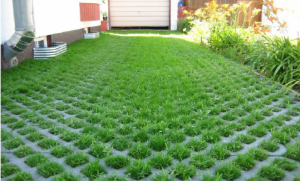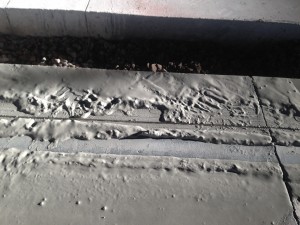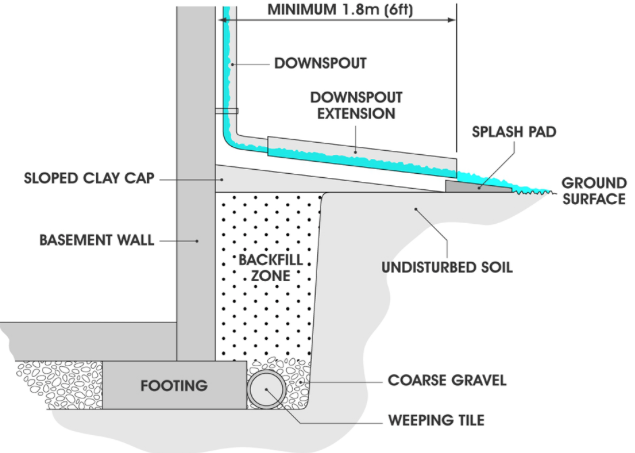Concrete Mitigation
Mitigation measures for concrete works must be done to ensure that concrete contaminated water or runoff is not allowed to enter into nearby watercourses. If concrete wash water is allowed to enter into watercourses untreated, the resultant increase in pH can be harmful or lethal to many of the aquatic organisms present. High levels of other contaminants as well as suspended solids are also harmful to aquatic organisms and the storm water system infrastructure.
Mitigation practices involve correctly cleaning concrete trucks and other equipment to ensure that the resultant concrete contaminated wash waters do not enter into the storm water system, preventing precipitation from coming into contact with uncured concrete, and properly managing the slurry created when concrete is cut or altered.
There are other techniques available to decrease the pH of concrete contaminated wash water, however, these techniques are often not required or are cost prohibitive for use on residential construction sites. Correctly managing concrete and concrete wash water will ensure that local watercourses are not damaged when concrete is poured onsite.
1. Equipment Washing
While concrete must be washed off equipment after it is poured to ensure that the equipment does not become damaged, concrete wash water cannot be allowed to enter into that storm water system. Examples of mitigation measures to ensure that concrete wash water does not enter into the storm water system include:
- Directing wash water to unpaved areas onsite, allowing the wash water to naturally, ensuring that no runoff reaches the storm water system
- On sites lacking areas for natural infiltration, add a sand and gravel base onsite and direct wash water to this area; remove and dispose of sand and gravel as required
- If safe onsite infiltration is not possible, collection of wash water for off site disposal will be necessary
- The City of North Vancouver has compiled information regarding concrete wash water disposal
- Watercourse protection bylaws on the North Shore prohibit concrete wash water from entering into the storm water system untreated
2. Precipitation & Concrete
Once poured, concrete cure for a set amount of time before it will no longer alter the pH of any resultant runoff that comes into contact with it. It takes approximately 28 days to cure cure to full strength, however there are many variables at play with respect to curing times including concrete type, depth, temperature and moisture content. Water coming into contact with curing concrete will still show an increase in pH, however, to what extent the resultant runoff pH is elevated also depends on many factors.
- Cover all concrete works with plastic sheeting, tarps or another type of barrier until fully cured, allowing for air to circulate between the concrete and the barrier itself
- Pay attention to the weather to time concrete pours accordingly, attempting to avoid pouring concrete during precipitation events
- Alternatives to concrete such as permeable pavers, gravel, sand or other materials can be used in place of concrete in many situations; these substances do not need to cure and will not raise the pH of runoff
- Alternatives to concrete such as permeable pavers and gravel also allow for infiltration to occur, reducing the amount of runoff generated from the site in the long term
3. Concrete Cutting
Concrete is cut for a variety of reasons including: relief cuts in driveways and sidewalks, cuts made to doors and window openings during renovations and cuts to foundation walls to install various services. When cured concrete is cut, a concrete slurry is often formed. Concrete slurry is the mixture of concrete solids and water that forms when cuts are made.
Similarly to concrete wash water, if concrete slurry is allowed to flow into the storm water system, an increase in pH and in suspended solids is seen in the receiving watercourse. This slurry has a negative effect on aquatic organisms and on the storm water infrastructure. Mitigation for concrete slurry is similar to concrete wash water, with the goal being to prevent all concrete slurry from entering into the storm water system.
Mitigation measures include:
- using a shop vacuum to clean up slurry as it forms
- Collect and remove slurry off site to be disposed off properly
- While flocculant systems can be used, they are often not practical for residential construction projects
Damp proofing and Drainage Mitigation
Damp proofing mitigation requires that the petroleum based product be applied to a dry structure during periods without precipitation. Damp proofing does not take long to dry and once dried, helps to seal the exposed concrete. If applied during dry weather, damp proofing is a good way to mitigate pH changes associated with concrete works.
Drainage works are necessary in order to keep the structure dry in the long term and help to channel water around and away from the newly built structure. Drainage features such as drain tile and gravel typically convey water to a sump, which then connects to the storm water system. If the water entering into this sump is contaminated with sediment or other materials, it is then conveyed directly into the storm water system. Care must be taken to ensure that clear and clean water enters into the storm water system by way of the drainage system.
It is important to remember that anything that passes through the drain tile of a home will end up in the storm water system and into the surrounding water courses. Drain tile is often used as a place to rinse out equipment but this practice needs to be halted. Drain tile is connected directly to the storm water system and therefore directly to nearby aquatic habitats.




